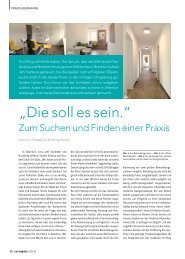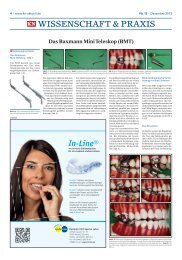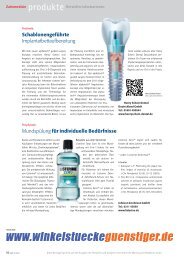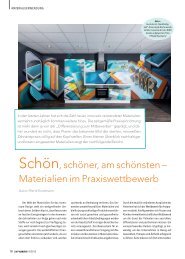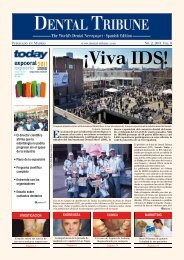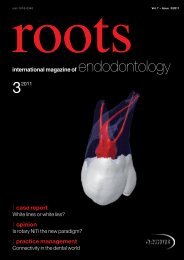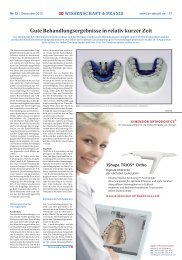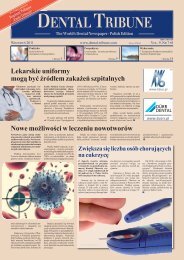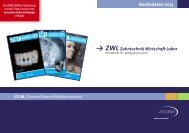Download - Oemus Media AG
Download - Oemus Media AG
Download - Oemus Media AG
Create successful ePaper yourself
Turn your PDF publications into a flip-book with our unique Google optimized e-Paper software.
26<br />
trends & applications DeNtal tribuNe | april-June, 2010<br />
Figs. 6a–d: Bilateral cross-bite in a seven-year-old boy (a). X-ray of the hybrid RPE appliance in situ (b). Status after ten days’ use: cross-bite has disappeared and vertical bite has remained stable (c, d).<br />
Figs. 7a–d: Anchorage of the canine using a miniscrew avoids protrusion of the anterior teeth when using a fixed Class II correction appliance (here: Williams appliance, FORESTADENT).<br />
Figs. 8a & b: The miniscrew stabilises the position of the molars to which the Kinzinger FMA is attached. This counteracts any protrusion of the premolars and<br />
an terior teeth (a). Class I dental status on completion of treatment (b).<br />
stable methods of acquiring<br />
more transverse space in the<br />
upper jaw. The targeted screw<br />
rate should be in the range of<br />
Fig. 9: The use of miniscrews to attach intermaxillary rubber traction bands<br />
means that no other attachments to the teeth are necessary.<br />
0.2 to 0.6 mm/day. As a rule,<br />
the appliance is fixed by means<br />
of bands to the molars & premolars.<br />
The desired transverse<br />
width can generally be achieved<br />
within 10 to 20 days. There<br />
after, a three-month stabilisation<br />
phase should be observed, in<br />
order to allow ossification of<br />
the ruptured pa latine suture.<br />
The standard anchorage technique<br />
with den tal support<br />
only has several disadvantages.<br />
The most significant is the risk<br />
of tipping the anchor teeth.<br />
Many appliances have been<br />
described that distribute the<br />
force over more than one tooth.<br />
A further problem is apparent<br />
here: as it is necessary to leave<br />
the appliance in place for a<br />
longer period after the active<br />
phase, it is only possible to<br />
commence further corrective<br />
treatment for teeth in the anterior<br />
region. It is possible to<br />
overcome these problems by<br />
using the ‘hybrid RPE’ (Figs.<br />
4–6). Bands are employed as<br />
usual in the molar region.<br />
In the anterior region, the RPE<br />
appliance is fixed using two<br />
miniscrews. These should<br />
be placed on a notional transverse<br />
line connecting the canine/<br />
premolar contact points paramedially.<br />
Distraction is achieved<br />
using the same method as in<br />
standard techniques. There are<br />
several advantages to hybrid<br />
RPE. Preparation of the apparatus<br />
is much simpler and<br />
cheaper, whilst the dental arch,<br />
including the premolars, is<br />
accessible for additional tooth<br />
correction measures.<br />
Class II corrections<br />
In the case of patients with<br />
Class II malocclusion who have<br />
completed or are near com -<br />
pleting their growth phase,<br />
simple techniques for the forward<br />
po sitioning of the lower<br />
jaw are usually ineffective.<br />
Following a thorough initial<br />
exami nation and diagnosis,<br />
there are three possible therapeutic<br />
approaches: camouflage,<br />
fixed Cass II correctional appliances<br />
(Herbst splint, Sabbagh<br />
Uni versal Spring, FMA, Jasper<br />
Jumper etc.) or orthognathic<br />
surgery. The patient must be<br />
informed of the advantages<br />
and dis ad vantages of each<br />
approach. All fixed Class II<br />
Figs. 10a–d: Missing tooth 12 is to be replaced by an implant-based crown. The initial phase of treatment involves widening the gap (a). The head of the vertically inserted OrthoEasy screw (b) is used to<br />
anchor a provisional crown (including bracket), which serves to widen the gap further (c).



